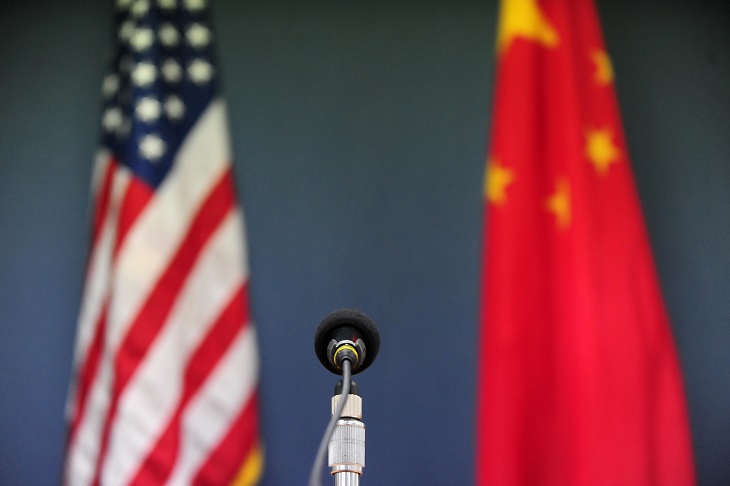In his 1966 book Tragedy and Hope, Carroll Quigley noted that the Chinese communist regime in the 1950s was insanely aggressive. The Nationalist government they replaced had been just as expansionist. It was allegedly a Nationalist fishing boat that set out to seize the South China Sea in 1947, even as they were fighting the communists. After, Mao’s policies kept China very poor for decades, turning military aggression inward. China’s only major attacks were on Tibet, the Soviet Union in 1969, Vietnam from 1979-91, skirmishes with India.
As China became wealthy, its military-lust rose. It built bases in the South China Sea on disputed islands, and started attacking India boarders while baiting Japan. China wants desperately to depose American military supremacy and its currency so that it will be acknowledged as the superior force by every other country on the planet. It has been doing this through diplomatic arrangements within the Shanghai Cooperation Organisation.
Mao also left a time bomb in China’s demographics. China could have started a one-child policy in the 1960s and kept their population at 700 million. Instead, it blew out to beyond 1.4 billion. If the West is forced to fight China, something no one is in a hurry to do, it won’t be the whole 1.4 billion. Instead, the West would face roughly 300 million soldiers concentrated in coastal provinces that produce goods for the global economy.
The rest of the population would be a drain on the Chinese war effort, diverting enormous volumes of resources to keep them fed, clothed, and not rioting – as happens domestically in situations like this. It is a problem that has faced all large armies and populations, from modernity to antiquity. Large armies are good for quickly overpowering smaller forces, but terrible for prolonged conflict under economic stresses.
If China had kept their population at 700 million, they would have a better cash flow than they do now and be a lot more powerful. We should be thankful to Mao and his mistake.
China has another quirk. While in a modern economy only 2 per cent of the population is engaged in agriculture that feeds the rest of the country, in China 25 per cent of the population works the land. Most of these people are desperately poor and only produce enough to feed themselves. The rest of the country’s farmers cannot be taken off the land and given a rifle without food production dropping.
Adding to the problem of food security is the reality that 20 per cent of China’s protein is imported, mainly as soy and corn to feed pigs and chickens. China has stockpiled hundreds of millions of tonnes of grain, but a protracted war will create 1.2 billion involuntary vegetarians. All this imported food has to be dragged across the Pacific. Disruptions to Pacific supplies of food would prove catastrophic very quickly with 1.4 billion mouths to feed. Russia planned for its invasion of Ukraine to take three days. It has now been going on for 17 weeks and could yet see its second winter. That situation will give Xi Jinping pause.
Another constraint on China is the evolution of electronics over the last 30 years. This has favoured defence. In the old days, you first became aware of the enemy fleet when it appeared over the horizon. You were trading shells minutes later. These days, nations know the location of every enemy ship most of the time, usually from the second they roll off the production line. They can be sunk while still tied up at the pier, as Ukraine has done to Russian ships in Crimean ports.
China is surrounded by islands that have airstrips that can host aircraft carrying anti-ship missiles with ranges up to 2,000 km. To put that into context, an aircraft with a range of 3,000 km taking off from Darwin could sink ships as far away as Korea. In the second world war, Australian Catalina seaplanes sunk Japanese shipping vessels along the South China coast. Their modern equivalents could do the same. If we had those modern equivalents…
China can build one of its Type 055 destroyers for US$920 million and it will cost about US$25 million to sink it using five BrahMos missiles at US$5 million each. The Philippines is buying three BrahMos batteries from India. This is the ground-launched version that could reach the Chinese coast from Luzon.
China has arguably (although not entirely confirmed) the largest navy on the planet, which is something you will need if you want to invade another country. Whatever they spent on building that navy it will only take about 5 per cent of that sum to put it at the bottom of the South China Sea using air-launched cruise missiles.
Ships have only so many of their vertical launch tubes devoted to missiles for shooting down aircraft and cruise missiles. Once those are expended the ship is defenceless and must return to port to have the tubes reloaded. And since the cost of these surface-to-air missiles can be more than the cost of the cruise missiles thrown at them, the engagement cost ratio does not favour the ship. And to detect incoming missiles, the ship has to use its radar which acts as a beacon broadcasting the ship’s location for hundreds of kilometres. These days ships are just floating targets and the western Pacific is now like the Mediterranean during the second world war, constantly in danger of attack by land-based aircraft.
If all that is true, why is the United States still building aircraft carriers? The answer is inertia. In the Falklands War, the UK held its carriers well to the east of the islands such that the effectiveness of its fighter aircraft were somewhat diminished. In the coming war with China, American carriers will be somewhere east of Guam and likely completely useless. A good parallel in history can be found when the US Army still had cavalry right up to the German invasion of Poland. When reports came in that the Polish cavalry was being decimated by German machine guns, the head of the army asked his chief cavalry officer what he was going to do about it. The latter replied that they would use trucks to take the horses closer to the front line. The cavalry arm was ordered to disband that afternoon.
The Chinese are building aircraft carriers too, but largely because they have slavishly copied America in most things.
A big difference between the second world war and any potential war with China is that nations broadly friendly to the West and wary of Chinese expansionism hold all the islands in the western Pacific. We don’t need aircraft carriers as mobile airfields. The second world war started with the Japanese holding the belt of islands from Palau in the west to the Marshall Islands in the east. This was a stretch of ocean 4,000 kilometres wide across Australia’s north. We don’t have to fight our way through that belt this time, but the Chinese have to. No doubt this explains their desperate bid to buy a path south.
What the US Marine Corps is doing is instructive. The current commander decided that the Marines’ role is to support the US Navy. And this will be done by manning missile batteries on island bases to sink the approaching Chinese ships. They have parked up their tanks and reduced the emphasis on big-deck amphibious ships to go asymmetric on the Chinese. That decision is looking good in the light of the Russian tank losses in Ukraine.
If there is to be a war over Taiwan, China desperately wants it to be quick in which its forces decisively defeat the United States, a latter-day Straits of Tsushima job, and then it will be free to throw its weight around in the region ever after. But circumstances of geography, trade, energy and weapon exchange rates will make the task very difficult. That won’t stop them from devising a plan that might make it possible and then causing a lot of deaths in the attempt.
America is run once again by people who loathe it and want to diminish its standing. The US nuclear shield may not be permanent. In a world that might become more fragmented, Australia needs to ally with Japan. We already have a defence treaty with Japan, but both countries need a far deeper and symbiotic relationship in which Japan provides the nuclear and missile technologies and Australia supplies carbon-based fuels, rare earths, and strategic depth. Japan should have short and medium range nuclear weapon delivery systems and Australia should host the long range systems, trotted out of tunnels in the McDonald Ranges on transporter-erector-launcher systems.
David Archibald is the author of American Gripen: The Solution to the F-35 Nightmare and The Anticancer Garden in Australia.
Got something to add? Join the discussion and comment below.
Get 10 issues for just $10
Subscribe to The Spectator Australia today for the next 10 magazine issues, plus full online access, for just $10.


























Comments
Don't miss out
Join the conversation with other Spectator Australia readers. Subscribe to leave a comment.
SUBSCRIBEAlready a subscriber? Log in